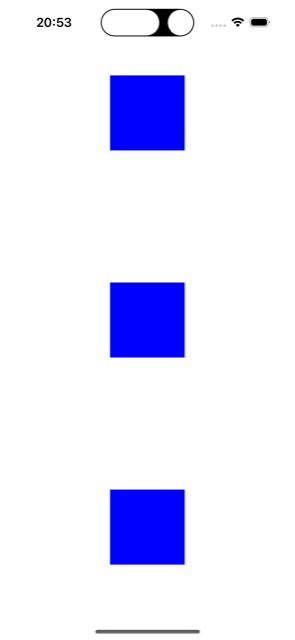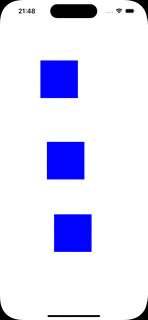Coordinating multiple gesture recognizers
So how does one actually work with multiple gesture recognizers on same view?

Let’s recreate the MoveMe sample with UIGestureRecognizer. The idea is to have both UILongPressGestureRecognizer and UIPanGestureRecognizer play nicely with each other. With UILongPressGestureRecognizer responsible for detecting selection and UIPanGestureRecognizer responsible for dragging the selected squares.
Setup
We have a SquareView that can react to changes such as selection and change in position. The main updates happen in layoutSubviews. setNeedsLayout reschedules a update at next draw cycle and layoutIfNeeded requests an update immediately.
struct SquareViewProps {
var color = UIColor.blue
var scale: CGFloat = 1.0
var position: CGPoint
}
class SquareView: UIView {
private var props: SquareViewProps {
didSet { setNeedsLayout() }
}
override init(frame: CGRect) {
props = SquareViewProps(position: CGPoint(x: frame.midX, y: frame.midY))
super.init(frame: frame)
}
override func layoutSubviews() {
super.layoutSubviews()
backgroundColor = props.color
center = props.position
transform = CGAffineTransform(scaleX: props.scale, y: props.scale)
}
private func resetProps(_ props: SquareViewProps) {
self.props = props
UIView.animate(withDuration: 0.3, delay: 0, options: [.beginFromCurrentState]) {
self.layoutIfNeeded()
}
}
}
And then we can host the SquareView in some parent UIView or UIViewController
class ViewController: UIViewController {
private var squareVws: [SquareView] = []
override func viewDidLoad() {
super.viewDidLoad()
squareVws = (0..<3).map { idx in
SquareView(
frame: CGRect(
x: view.bounds.midX - 50,
y: CGFloat.lerp(
start: (view.bounds.minY + 100),
end: (view.bounds.maxY - 200),
factor: CGFloat(idx) / 2
),
width: 100, height: 100
)
)
}
squareVws.forEach { view.addSubview($0) }
}
}

Problem
Next we can add a UIPanGestureRecognizer on the ViewController and forward the gesture events to selected views.
enum GestureEvent {
case began
case changed(CGPoint)
case ended
}
class SquareView: UIView {
func handleGestureEvent(_ event: GestureEvent) {
switch event {
case .began:
resetProps(SquareViewProps(
color: .red,
scale: 1.2,
position: props.position
))
case .changed(let translation):
props.position = CGPoint.add(translation, props.position)
case .ended:
resetProps(SquareViewProps(position: props.position))
}
}
// ...
}
class ViewController: UIViewController {
private var squareVws: [SquareView] = []
private var selectedVws: [SquareView] = []
override func viewDidLoad() {
// ...
let dragGesture = UIPanGestureRecognizer(
target: self,
action: #selector(handleDrag)
)
view.addGestureRecognizer(dragGesture)
}
@objc func handleDrag(_ sender: UIPanGestureRecognizer) {
switch sender.state {
case .began:
let pt = sender.location(in: view)
selectedVws = squareVws.filter { $0.frame.contains(pt) }
handleGestureEvent(.began)
case .changed:
let translation = sender.translation(in: view)
handleGestureEvent(.changed(translation))
sender.setTranslation(.zero, in: view)
case .ended:
handleGestureEvent(.ended)
selectedVws = []
default:
break
}
}
func handleGestureEvent(_ event: GestureEvent) {
selectedVws.forEach { $0.handleGestureEvent(event) }
}
}
So far so good but with this implementation we receive gesture events after the drag has started but we want to receive the .began as soon as the user touches the square. We can use the UITapGestureRecognizer but it only activates at touch up and not at touch down. So either we need to rollout our own gesture or ‘hack’ UILongPressGestureRecognizer
class ViewController: UIViewController {
private var squareVws: [SquareView] = []
private var selectedVws: [SquareView] = []
override func viewDidLoad() {
super.viewDidLoad()
// ...
let tapGesture = UILongPressGestureRecognizer(
target: self,
action: #selector(handleTap)
)
tapGesture.minimumPressDuration = 0.1
let dragGesture = UIPanGestureRecognizer(
target: self,
action: #selector(handleDrag)
)
view.addGestureRecognizer(tapGesture)
view.addGestureRecognizer(dragGesture)
}
@objc func handleTap(_ sender: UILongPressGestureRecognizer) {
switch sender.state {
case .began:
let pt = sender.location(in: view)
selectedVws = squareVws.filter { $0.frame.contains(pt) }
handleGestureEvent(.began)
case .ended:
handleGestureEvent(.ended)
selectedVws = []
default:
break
}
}
@objc func handleDrag(_ sender: UIPanGestureRecognizer) {
switch sender.state {
case .changed:
let translation = sender.translation(in: view)
handleGestureEvent(.changed(translation))
sender.setTranslation(.zero, in: view)
default:
break
}
}
func handleGestureEvent(_ event: GestureEvent) {
selectedVws.forEach { $0.handleGestureEvent(event) }
}
}
But this poses another problem. On a UIView by default only one gesture recognizer is active at a time. So once the UILongPressGestureRecognizer is activated UIPanGestureRecognizer is ignored.
Solution
Gesture recognizers have a defined order of precedence. So if multiple gesture recognizers are attached to a view, the winner is decided by the default rules. But we can override the rules by implementing the UIGestureRecognizerDelegate. For our case since each gesture recognizer is listening to different states we can have both the gestures active at the same time
class ViewController: UIViewController {
// ...
override func viewDidLoad() {
super.viewDidLoad()
let tapGesture = UILongPressGestureRecognizer()
let dragGesture = UIPanGestureRecognizer()
// ...
tapGesture.delegate = self
dragGesture.delegate = self
}
}
extension ViewController: UIGestureRecognizerDelegate {
public func gestureRecognizer(
_ gestureRecognizer: UIGestureRecognizer,
shouldRecognizeSimultaneouslyWith otherGestureRecognizer: UIGestureRecognizer
) -> Bool {
return gestureRecognizer is UILongPressGestureRecognizer
&& otherGestureRecognizer is UIPanGestureRecognizer
}
}

The solution is available on https://github.com/chunkyguy/MoveMe